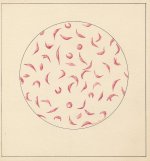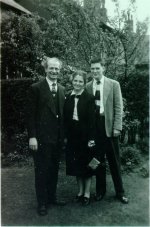
The Postwar Years, Part 2 (1948-1949)
1948
Pauling and his family arrive at Oxford on New Year’s Day and have to live in a hotel for three-and-a-half weeks. They then move into a flat. Pauling begins his George Eastman Professorship during which he lectures on the chemical bond as well as on molecular structure and biological specificity.
On February 2, Pauling is awarded the Presidential Medal for Merit "for exceptionally meritorious conduct in the performance of outstanding services to the United States from October 1940 to June 1946." (Later in the year, on October 4, CIT holds a convocation for the five faculty members who received the Medal for Merit: Lee A. DuBridge, William A. Fowler, Max Mason, Linus Pauling, and Bruce H. Sage.)
In the spring, Pauling attacks again the problem of the structure of proteins and this time he finds that he can formulate a structurally satisfactory helical configuration. He does this by sketching a polypeptide chain of amino acids on a piece of paper and then rolling the paper so that he can form hydrogen bonds between certain amino-acid groups. The alpha helix that results contains a nonintegral number of amino-acid residues per turn of the helix. Because his model appears to contradict the data from X-ray crystallography, he tells Ava Helen but no one else about his structure.
On May 28, Pauling delivers the 21st Sir Jesse Boot Foundation Lecture at the University of Nottingham. He speaks on "Molecular Architecture and the Processes of Life." His general theme is on his molecular approach to the chemical problems posed by molecules from living things. He also mentions nucleoprotein molecules, which, he says, are the molecules that determine the characters of individual living organisms and are involved in the transmission of these characters to progeny. Toward the end of the paper, he speculates that the genetic molecule may act as a template that causes the formation of a molecule with a complementary (not an identical) structure.
In June, Linus and Ava Helen Pauling, with family and friends, celebrate their 25th wedding anniversary at Balliol College in Oxford University.
Pauling receives an honorary Doctor of Science degree from Oxford University (T.S. Eliot receives a Doctor of Letters degree at the same ceremony).
Pauling receives an honorary degree from the University of Paris.
On his return to CIT, Pauling takes up his various researches. He and his collaborators continue to publish papers on the serological properties of simple substances. By this time, hundreds of experiments have been done, and they have an excellent understanding of the interactions of antibodies with haptenic groups.
Pauling publishes an influential paper on the metallic state in Nature.
Richard C. Tolman dies in Pasadena on September 5, 1948.
Pauling is vice-chairman of the Progressive Citizens of America, the group which backs Henry Wallace for president. Pauling votes for Wallace in the November elections, but the candidate Ava Helen votes for, Harry S. Truman, wins.
1949
Pauling becomes president of the American Chemical Society for 1949. On January 3, he delivers his presidential address in which he urges American industrial corporations to support a scientific research foundation that will insure them a steady supply of new products. He also makes clear that he is not sympathetic with the aims of the American Medical Association, for he feels that "a system of socialized medicine in the United States may well be desirable." Pauling’s address causes criticism from both the liberals and conservatives in and outside of the scientific community.
In April, Pauling and Itano, with S.J. Singer and Ibert Wells, present their results on sickle-cell anemia as a molecular disease at a meeting of the National Academy of Sciences in Washington, D.C. (it will be published in Science at the end of November, and it becomes one of his most-cited papers and has a wide and long lasting influence).

Drawing of abnormal (sickled) red blood cells by Roger Hayward, ca. 1964.
LP Manuscripts of Books, 1964b4.1
Pauling publishes a paper, "A Resonating Valence-Bond Theory of Metals and Intermetallic Compounds," in the Proceedings of the Royal Society (London). Scientists from many fields often refer to this treatment in the years after its initial appearance.
In the Soviet Union, Pauling’s resonance theory of the chemical bond comes under attack as an idealistic and reactionary theory by a bourgeois scientist.
Dr. Thomas Addis dies on June 4. Pauling becomes a member of the Addis Memorial Committee whose purpose is to collect funds to be used for the support of the Addis Memorial Wing of a new outpatient clinic of the Varsovie Hospital at Toulouse, France.
Table of Contents
- The Ancestry of Linus Pauling (The Paulings)
- The Ancestry of Linus Pauling (The Darlings)
- Linus Pauling's Childhood (1901-1910)
- Linus Pauling's Adolescence (1910-1917)
- Pauling's Years as an Undergraduate at Oregon Agricultural College, Part 1 (1917-1919)
- Pauling's Years as an Undergraduate at Oregon Agricultural College, Part 2 (1919-1922)
- Linus Pauling as a Graduate and Postdoctoral Student at the California Institute of Technology, Part 1 (1922-1923)
- Linus Pauling as a Graduate and Postdoctoral Student at the California Institute of Technology, Part 2 (1924-1926)
- A Guggenheim Fellow in Europe during the Golden Years of Physics (1926-1927)
- Early Career at the California Institute of Technology (1927-1930)
- Pauling's Great Years of Achievement in Structural Chemistry, Part 1 (1931-1932)
- Pauling's Great Years of Achievement in Structural Chemistry, Part 2 (1933-1935)
- Pauling's Increasing Involvement in Molecular Biology (1936-1939)
- The War Years, Part 1 (1940-1942)
- The War Years, Part 2 (1943-1945)
- The Postwar Years, Part 1 (1946-1947)
- The Postwar Years, Part 2 (1948-1949)
- Proteins, Passports, and the Prize (1950-1954)
- Increasing Involvement in World Peace, Part 1 (1955-1958)
- Increasing Involvement in World Peace, Part 2 (1959-1963)
- The Center for the Study of Democratic Institutions (1964-1967)
- The University of California, San Diego (1968-1969)
- Stanford University (1969-1972)
- An Institute for Science and Orthomolecular Medicine, Part 1 (1973-1977)
- An Institute for Science and Orthomolecular Medicine, Part 2 (1978-1981)
- The Years Alone: Pauling after the Death of Ava Helen, Part 1 (1982-1988)
- The Years Alone: Pauling after the Death of Ava Helen, Part 2 (1989-1994)
- About the Author


